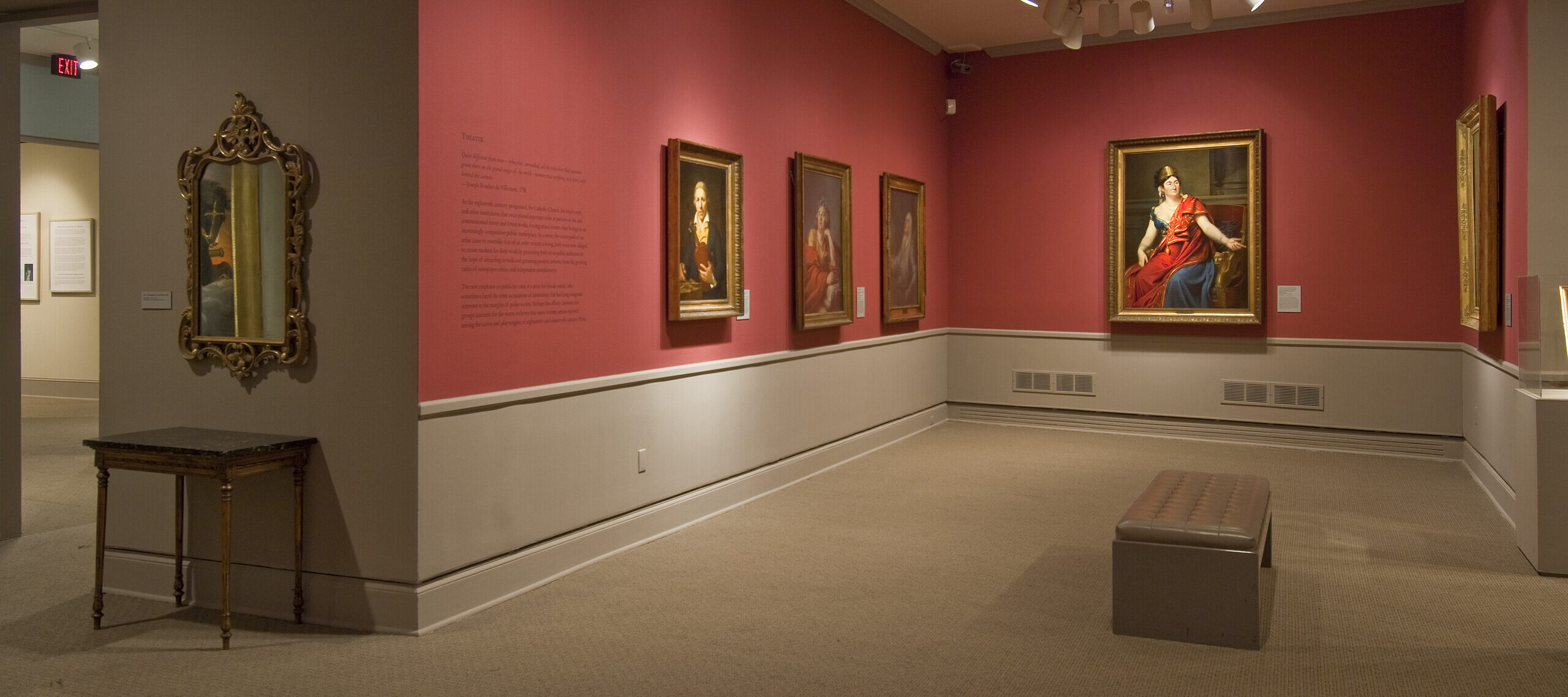In Royalists to Romantics: Women Artists from the Louvre, Versailles, and Other French National Collections, 77 works by 35 artists display the talents of French Revolution-era women artists. Their paintings are windows into their careers and the singular challenges of their time. The catalogue that NMWA has published to illustrate Royalists to Romantics includes essays as well as individual artist biographies that give insight into the lives of women artists working in France between 1750 and 1848. This excerpt explores the life of one the show’s featured artists, Adrienne Marie Louise Grandpierre-Deverzy.

A prolific and recognized artist, Grandpierre-Deverzy was a student, a colleague, and, from 1856 until her death, the second wife of the history painter Abel de Pujol (1787–1861).¹ From 1822 to 1855 she exhibited regularly at the Paris Salons, sending portraits, genre scenes, and history paintings. Her narrative paintings generally feature subjects selected from modern European history and literature, and associated with the Troubadour style. Her 1824 Salon offerings included the deceptively titled View of a Portion of the Château of Fontainbleau (untraced), which depicts the seventeenth-century queen Christina of Sweden having Monaldeschi, her equerry, murdered (a subject treated by Félicie de Fauveau, among others), and a scene (untraced) from the picaresque eighteenth-century novel The Adventures of Gil Blas of Santillane.² In 1828 she received a silver medal from the Societe des amis des arts of Cambrai.

Grandpierre-Deverzy was also a committed teacher who gave lessons and assisted Pujol during the separate studio hours that he maintained for female pupils. Her 1822 Studio of Abel de Pujol, displayed at her Salon debut and included in the exhibition, depicts the seated Pujol critiquing a drawing held on his lap while more than a dozen young women, scattered about the space, paint, chat, select pigments, or, at the right, simply gaze out the window.³
Gender-appropriate instructional aids abound, including the clothed female model seated in the left rear corner, copies after three identifiable religious paintings by Pujol, who specialized in that genre, and a shelf of plaster casts with a male nude torso turned decorously, if playfully, toward the wall. Grandpierre-Deverzy reprised the theme of the atelier twice: once at the 1836 Salon, which included the scene of Pujol’s male studio also in the exhibition, and once in 1855. The 1836 painting includes a nude female model who, posing for the male artist at the left, maintains decorum by turning her back to the viewer.⁴
These studio scenes are Grandpierre-Deverzy’s best-known paintings. The 1822 painting became emblematic of the very idea of women’s artistic practice when it served as the cover image for the catalogue of the groundbreaking 1976 exhibition Women Artists, 1550–1950, curated by Ann Sutherland Harris and Linda Nochlin.
Notes
1. All sources consulted for this biography concur that Grandpierre-Deverzy studied with Pujol. These include E. Bénézit, Dictionnaire critique et documentaire des peintres, sculpteurs, dessinateurs, et graveurs de tous les temps et de tous les pays par un groupe d’écrivains spécialistes français et étrangers, new ed. (Paris, 1999), vol. 6, p. 569; Gen Doy, Women and Visual Culture in Nineteenth-Century France, 1800–1852 (London and New York, 1998), pp. 38–39; La femme artiste: D’Élisabeth Vigée-Lebrun à Rosa Bonheur, exh. cat. (Mont-de-Marsan, 1981), pp. 57–59; Charles Gabet, Dictionnaire des artistes de l’école française, au xixe siècle (Paris, 1831), p. 325; and Ann Sutherland Harris and Linda Nochlin, Women Artists, 1550–1950, exh. cat. (New York, 1976), pp. 219–21. However, Elizabeth E. Guffey, Drawing an Elusive Line: The Art of Pierre-Paul Prud’hon (Newark, de, 2001), p. 169, additionally refers to Grandpierre-Deverzy as a “former student of David,” though her name does not appear in the list of David’s female students published in Mary Vidal, “The ‘Other Atelier’: Jacques-Louis David’s Female Students,” in Women, Art and the Politics of Identity, ed. Melissa Lee Hyde and Jennifer Milam (Aldershot, 2003), pp. 257–58.
2. Both of these works are listed as untraced in Émile Bellier de la Chavignerie, Dictionnaire général des artistes de l’école française depuis l’origine des arts du dessin jusqu’à nos jours (1882–85; rpr., Paris, 1997), vol. 1, p. 687.
3. This painting is discussed by the scholars cited above and by Christine Havice, “In a Class by Herself: 19th Century Images of the Woman Artist as Student,” Woman’s Art Journal 2, no. 1 (Spring-Summer 1981), p. 37, and Alexandra K. Wettlaufer, “Dibutades and Her Daughters: The Female Artist in Postrevolutionary France,” Nineteenth-Century Studies 18 (2004), pp. 22–23.
4. See Susan Waller, The Invention of the Model: Artists and Models in Paris, 1830–1870 (Aldershot, 2006), pp. 47–48.
